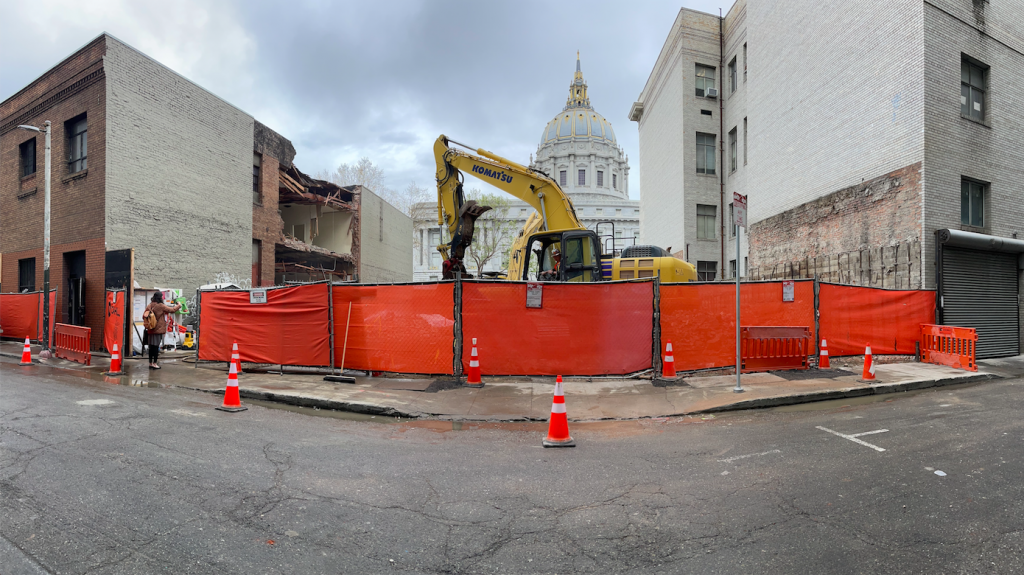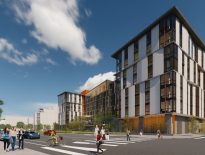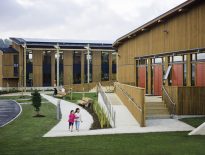Home for More: “Disability- Forward” Affordable Housing in San Francisco
Projects pursuing Core and Living Building Certification are required to meaningfully integrate universal design into their structures. This project is a fantastic case study of prioritizing universal design and integrating it with broader environmental and health goals.
The Kelsey is a Bay Area non-profit organization dedicated to advancing ‘disability-forward’ housing options. The Kelsey has found that while 26% of Americans have a disability, only 6% of housing is accessible to people with disabilities, a statistic they hope to improve. The Kelsey’s organizational ethos is ‘more’ – ‘more housing, more inclusion, more community’ – ultimately leading to more opportunities for all. This drive for more was inspired by their co-founder and namesake, Kelsey O’Connor, who often signed “more” to push them to remember to do more. The Kelsey believes that by centering the needs of the most marginalized and, in particular, those with disabilities, everyone benefits. In the spirit of ‘more,’ the Kelsey has registered their latest project, the Kelsey Civic Center, for ILFI’s Core Certification and is a participant in ILFI’s Affordable Housing Program. Architect Pauline Souza of WRNS Studio says that the project will help dispel the notion that “good enough is enough.”
The building will create over 100 new affordable housing units two blocks from Market Street, the economic center of the city. The neighborhood is particularly meaningful because it has a rich history in disability rights and other social justice movements. The Kelsey Civic Center, co-developed with Mercy Housing California, is intended to create a place where those with disabilities and those without disabilities live together in a shared community. Its location across from City Hall also makes it easy for residents to advocate for their needs and community. The programming of the building is cohousing ‘in spirit’ with community spaces crafted to foster informal support networks and interdependence. The building will include a Disability Community Culture Center, which is the first center of its kind to allow connection and a physical place to share experiences.
This project, as with all projects developed by the Kelsey, will be a model of Universal Design and help promote cross-disability solutions that are affordable to integrate. The project team engaged Universal Design Consultant and Architect, Erick Mikiten of Mikiten Architecture, on this project and others. His goal for universal design is to move it away from an “annoying accommodation and medical adaptation” and towards a result of more “graceful and thoughtful architecture for everyone.” As an example, he explains that the Kelsey Civic Center project discussed adding a curve to the building where the project has an 8-story, relatively narrow atrium. This improves the experience of the building for multiple users: it alleviates the disorientation from the atrium that those with certain cognitive or perception issues can encounter, the curve is more natural for the path of a wheelchair, and it helps blind residents immediately recognize which area of the building they are walking through by the tactile experience.
Ideas like this helped inform the Kelsey’s recently published Housing Design Standards for Accessibility and Inclusion, on which Mikiten also consulted. The Housing Design Standards were intended to give developers and architects a better understanding of how to employ universal design strategies in their buildings in an effective and implementable way. The guide emphasizes that codes and compliance with the American with Disabilities Act often focuses solely on physical accessibility and does not address the range of diverse needs, such as sensory or cognitive impacts. The Kelsey staff also hope that the design standards can help move away from a ‘check box’ mentality and towards integrating universal design in an intentional, mission-driven way, not as a baseline requirement that is never surpassed.
To learn more about the Kelsey Civic Center project and the Kelsey’sHousing Design Standards for Accessibility and Inclusion, we interviewed Fatimah Aure, Director of Field Building and Capacity at the Kelsey.
1. What is the guiding mission of your organization, The Kelsey?
The Kelsey pioneers disability-forward housing solutions that open doors to more affordable homes and opportunities for everyone. We develop affordable, accessible, inclusive housing communities designed to scale and lead organizing and advocacy to create market conditions so inclusive housing becomes the norm. What started with Kelsey, an advocate for access and community, has become a movement towards an inclusive housing future led together by people with and without disabilities.
2. Can you describe your current ILFI pilot project, the Kelsey Civic Center? How do the goals of your organization relate to your current project the Kelsey Civic Center (which is pursuing Core certification and participating in ILFI’s Affordable Housing Program)?
The Kelsey Civic Center will be a vibrant urban community offering 112 homes for people of all abilities, incomes, and backgrounds. Located across from San Francisco City Hall, construction is targeted to start in late 2022. The Kelsey Civic Center will serve as a beacon of sustainability, disability inclusion, and equity in the heart of the city.
Twenty-five percent of the units will be dedicated to people with disabilities who use home and community-based services. This fully accessible and universally-designed building will provide programming for all residents and neighbors with the goal of fostering a mutually supportive environment rooted in the ethos of interdependence and informal support networks. Two full-time Inclusion Concierges™️ will help residents navigate their neighborhood, engage with their city, connect to programs and activities, and build community among residents of all abilities.
The Kelsey and its partners were awarded the site through Reinventing Cities, an unprecedented global competition organized by the C40 to drive carbon neutral and resilient urban regeneration. The Kelsey Civic Center will model that an all-electric, low carbon building can be affordable to people of all incomes. To support biodiversity and resident wellness the project will offer a sensory garden within the building’s courtyard and on the rooftop. Efficient individual units with shared spaces will minimize resource waste, support low carbon design, and foster a resilient community.
3. Can you describe the Housing Design Standards? Are they intended to be used as a reference for ideas, framework document, certification, or other?
The Housing Design Standards for Accessibility and Inclusion aim to equip designers, builders, and developers with guidelines and frameworks for disability-forward housing creation. The Design Standards define multifamily housing elements throughout the development process and address everything from the design approach to physical spaces, to mobility and reach to healthy materials selection, to even amenities, outdoor spaces, on-site staffing, and resident supports. A cross-disability approach provides elements that are specific to individualized access needs and others that benefit a diversity of disabilities. The elements were assessed on intersectional benefits alongside sustainability, affordability, racial equity, and a better resident experience.
4. What was the motivation for creating the Housing Design Standards for Accessibility and Inclusion? How were they developed?
26% of people have a disability, yet it’s estimated that less than 6% of the national housing supply is designed to be accessible. As housing communities are created, they don’t often meet the diverse accessibility and inclusion needs of people with disabilities. While code sets the baseline for what’s required, no holistic guidelines define an implementable, progressive approach to creating truly accessible and inclusive housing.
The Kelsey created the Design Standards in partnership with Erick Mikiten of Mikiten Architecture. They were shaped with the support and feedback from our Inclusive Design Council, a select group of disability advocates evaluating what works well for different access needs in their own lived experience, as well as workshops with designers, developers, and architects.
5. What does universal design mean to The Kelsey? Which kinds of access and needs are addressed by the Housing Design Standards?
Universal Design is the design of an environment that is usable by all people, and to the greatest extent possible. It doesn’t rely on special accommodations that separate users from each other, but creates a home that is usable by everyone in the same way.
All elements within the design standards are grouped by different access needs (rather than by a disability diagnosis). These are the access needs our standards address:
- Mobility and Height: Individuals who have limited use of their limbs, limited range of motion or dexterity, who use mobility supports (i.e., wheelchairs – manual and motorized; scooters; walkers; canes; grab bars), who have short stature, and/or who use assistive tools (i.e., reachers, step ladders, stools, etc.) to access spaces.
- Hearing and Acoustics: Individuals who are hard of hearing (HOH), use hearing supports and devices to engage in surrounding environments (i.e., voice amplification devices, hearing aids, video relay services, cochlear implants, ASL, etc.), and/or who have auditory sensory sensitivities.
- Vision: Individuals who are blind, who have low vision, and/or who use visual supports and devices to engage in surrounding environments (i.e., Braille, screen readers, magnifiers, lightboxes, etc.). This can also include people with high sensitivity to glare, or rapid changes in light levels.
- Health and Wellness: Individuals who have chronic health conditions, who have allergies and chemical sensitivities, are immunocompromised, and/or regularly utilize medical and/or therapeutic services. Aspects of the building that promote wellness for all, such as connection to nature and natural light, are also included.
- Cognitive Access: Individuals who process information differently, who have alternative language reception and/or communication preferences and needs, who need items or materials presented in different ways or speeds of information, and/or who use supports in understanding and content retention, information processing, and decision making or choice selection. Includes wayfinding support for memory or orientation.
- Support Needs: Individuals who use support services in their home and/or the community including but not limited to: direct support professionals, health aides, nursing support, behavioral supports, and individualized therapies. Can also include individuals using in-house family support for mobility or other assistance.
6. Why is accessibility a particularly important need for affordable housing?
People with disabilities experience poverty and discrimination at disproportionately high rates. The thoughtful physical as well as cognitive accessibility of housing designed to be affordable is desperately needed.
7. Can you explain what cross-disability means and how it is used in the standard?
Cross-disability means that a variety of disabilities with differing access needs were considered when creating the Housing Design Standards. At one time, accessibility was mistakenly isolated to people who use wheelchairs. The Housing Design Standards were developed with the purpose of addressing more than one type of accessibility and a variety of access needs, notably disabilities with cognitive and sensory needs.
8. What is the most important consideration or first step for project teams that want to incorporate more accessibility into projects?
Include people with disabilities early in your design process. By working with a universal design consultant or forming a community advisory board that includes people with disabilities, a project team has someone with lived experience to consult with on design choices. Like in any type of design, asking the ultimate end user of a product helps to create better outcomes and avoid unintended consequences.
9. Can architects and other project team members design accessibly without increasing overhead costs of the project?
Yes, if they start early. Projects that consider accessibility from the outset are more successful at integrating into the end project cost effectively versus spending costs and redesign dollars to integrate right before occupancy or as a reasonable accommodation. Designing for people with disabilities is simply better design. If you think up-front explicitly about maneuvering, lighting, way-finding, etc. you can integrate a lot of accessible elements without a lot of cost.
10. Anything else you would like us to know about the project?
The Kelsey Civic Center and The Design Standards for Access and Inclusion helped us identify elements that are good for both sustainability and disability access which could be helpful for many ILFI projects to consider. Some of these elements include:
- HEPA Filtration Systems
- Low and No VOC materials and chemical free spaces
- Mechanical systems that are easily used
- Managed daylighting
- Automatic shut-off features on appliances
- Access to alternatives to car ownership including car-sharing and on-demand rentals
You can take a virtual site tour of the Kelsey Civic Center Project and download the Housing Design Standards for Accessibility and Inclusion and other resources from their website.




